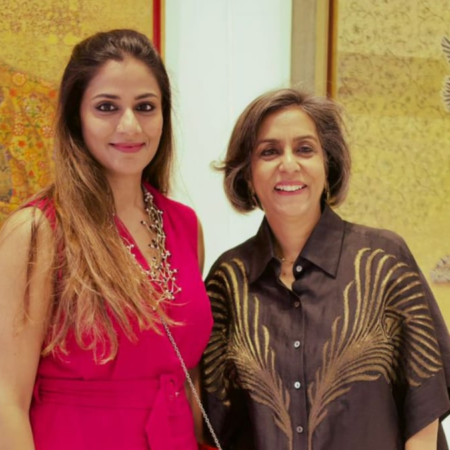Last Updated:
Vipula Monga, art consultant, shares her philosophy of buying art you can live with, championing emerging artists while balancing beauty and investment potential.

Vipula Monga (R) with artist Anika Jain
Stepping into the gallery where Vipula Monga staged her recent exhibition feels like entering a soaring corridor of stories, walls lined with canvases, stitched portraits, miniature-inspired works and bold freehand crayon drawings. The space hums with variety: textures, colours and ideas hang shoulder to shoulder, yet each piece asserts its individuality. It sets the mood for Monga’s philosophy, art that sparks dialogue, art that lives comfortably with people, and art that balances freshness with staying power.
Vipula Monga’s path into art consultancy began at the intersection of architecture, interiors and a long-standing love for contemporary Indian art. An architect by training who gradually stopped practising, she has spent the last 15 years building a private collection.
More recently, she has transformed that personal passion into a structured advisory practice, Ochre Art. Today, she advises private clients and corporate spaces, curates small exhibitions, and circulates e-catalogues of selected artists to her growing database. She is also preparing to launch a new website.
Aesthetics vs. investment: a pragmatic, client-sensitive balance
“With emerging artists, not every artist will see their value rise,” Vipula explains, “but some do appreciate significantly over 10–15 years.” Her evaluation focuses on craft, uniqueness and the intellectual content of the work. When collectors are looking for investment-grade works, she sources established names directly from artists or trusted galleries. “It really depends on the client, their budget, their taste, and whether they want something that moves them now or something that will grow in market value.”
Market currents: What is changing how collectors choose?
Vipula sees a generational shift, “The younger generation is looking for unusual, striking pieces. They don’t want regular landscapes or still life they want something that really stands out.” Millennials, she says, are more open to experimental techniques and bold colour, though some remain strictly investment-driven. “City to city, the response is different too, in Delhi, people lean towards figurative work, while other markets can be more experimental.”
Curating private homes vs. corporate spaces
Her curatorial approach shifts with context. “For homes, you have to live with that art, it should speak to you every single day,” she insists. Corporate collections, on the other hand, are about scale and neutrality. “In offices, abstract works often do better because they blend into the décor without overpowering it. But in a director’s office or a lobby, one large canvas can transform the space completely.”
Nudging clients toward the unfamiliar
Vipula believes in guiding without restricting, “I may give a hint about what works for my buyers, but I never tell an artist to change their colours or style. The market teaches us, I share that feedback, but the vision must remain theirs.” This dialogue, she explains, allows both artists and collectors to evolve naturally. “Sometimes clients fall in love with a work they would never have imagined choosing at first glance.”
Championing emerging artists
“As a consultant, I feel a responsibility to take emerging artists forward when I see potential,” Vipula says firmly. She curates with variety in mind: from textile-inspired canvases and freehand crayon works to embroidered portraits and miniature-influenced satire. “Each artist brings a different voice. My role is to give them exposure, help them understand the market, and connect them to collectors who are ready to take a chance.”
Technology and AI: helper, not replacement
“Technology definitely helps,” she notes. Many artists use digital tools for transfer, collage, or blending, but the creative intent remains theirs. “With AI, in India it’s still at a very early stage. A few collectors may experiment, but for most, the comfort is still with handmade work. Personally, I would always choose something created by hand, it carries the artist’s presence in a way AI can’t.”
From architecture to advisory
Her career in interiors gave her a natural entry into advising on art. “Clients didn’t always think about art, but I would suggest prints or affordable works to elevate a home or office. Over the years, collecting became a passion and people started asking me for advice.” That informal guidance has grown into Ochre Art, with structured consultancy, exhibitions and catalogues. “For me, art consultancy is a blend of passion and practice. It grew naturally out of my own collection.”
Building a timeless collection
Her advice is refreshingly simple: “Don’t buy because it’s trendy or Instagram-friendly. Buy something you want to see every day.” For her, timelessness lies not in big names but in a personal connection. “If a work speaks to you and makes you smile, that’s the art you should live with. Trends will pass, but what you love will always remain relevant.”
Vipula Monga’s approach is defined by curiosity, sensitivity and a firm belief in collaboration. She measures success by whether a work can become part of someone’s everyday life. Her advice to new collectors? “Be intentional, be curious, and keep your eyes open for emerging artists. Even if you don’t buy immediately, engage with the work. See it in person. Let it speak to you, that’s how a collection becomes truly yours.”

Swati Chaturvedi, a seasoned media and journalism aficionado with over 10 years of expertise, is not just a storyteller; she’s a weaver of wit and wisdom in the digital landscape. As a key figure in News18 Engl…Read More
Swati Chaturvedi, a seasoned media and journalism aficionado with over 10 years of expertise, is not just a storyteller; she’s a weaver of wit and wisdom in the digital landscape. As a key figure in News18 Engl… Read More
September 16, 2025, 13:08 IST











No Comment! Be the first one.